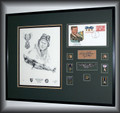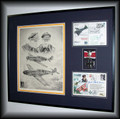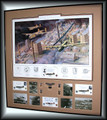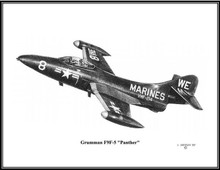 Loading... Please wait...
Loading... Please wait...Categories
Our Newsletter
- Home
- Combat Aircraft/Pencil Drawings ~ Free Shipping
- Grumman F9F-5 "Panther" ~ Free Shipping
Product Description
***CLICK ON IMAGE TO ENLARGE***
Print Size 8½ x 11 ----- Unlimited print edition
The F9F-5 was numerically the most important of the Panther variants. It had the longer fuselage and revised tail surfaces of the F9F-4, but was powered by the Pratt & Whitney J48 turbojet, a license-built version of the Rolls-Royce Tay. The XF9F-5 prototype was the 100th production airframe (F9F-2 BuNo 123085), modified and re-engined. It flew for the first time on December 21, 1949. It actually preceded the XF9F-4 into the air by almost half a year. 616 F9F-5s were delivered to the Navy and Marine Corps between November 1950 and January 1953. They were all powered by the Pratt & Whitney J48-P-6 or P-6A, rated at 7000 lb.s.t. wet. The F9F-5 had four external store pylons underneath each wing, with the three outboard pylons being stressed to carry bombs of up to 500 pounds in weight. Maximum external load was 3465 pounds. During the course of production, an anti-stall fence was added just outboard of the wing roots to control the airflow and reduce landing speed. Many of the F9F-4s were retrofitted with J48 engines and thus became indistinguishable from F9F-5s. The first F9F-5 deliveries took place on November 5, 1950. Most squadrons which had been equipped with F9F-2s were re-equipped with the later F9F-5. In November 1951, the F9F-5 replaced the F9F-2s of the Blue Angels flight demonstration team. This team began to convert to the swept-wing F9F-6 Cougar in 1953, but it turned out that these Cougars were urgently needed by the fleet and the team had to be hastily re-equipped with overhauled F9F-5s. The F9F-5s served with the Blue Angels until 1954, when they were finally replaced by F9F-8 Cougars. The first F9F-5s entered combat in Korea in October of 1952, serving aboard the USS Oriskany (CVA-34) with the reserve squadrons VF-781 and VF-783. They were also flown by VF-51, VF-52, VF-53, VF-111, VF-153, and VF-154 during the latter stages of the Korean War. They provided the backbone of the Navy's carrier-based jet-powered ground attack capability during the last year of the Korean War. One of the more significant experiments carried out by the F9F-5 was the performance of early midair refuelling tests. F9F-5 BuNo 125240 was fitted in 1952 with a refuelling probe in the nose for trials with a North American XAJ-1 attack plane modified as a tanker. These tests were so successful that the Navy eventually decided in September of 1955 to require that all of its jet-powered fighters and attack aircraft would henceforth be equipped for midair refuelling. As the Panther began to be replaced in active service by more advanced types, surviving F9F-5s were modified as F9F-5K remotely-controlled drones or as F9F-5KD drone directors. In the F9F-5KD, the nose guns were removed and were replaced by radio control equipment. In 1962, the Defense Department introduced the new Tri-Service designation scheme under which the separate USAF/Navy designations were replaced by a new unified designation system. This required that all existing Navy aircraft be redesignated. By this time, the only Panthers remaining in Navy service were the F9F-5KD drone directors, which were redesignated DF-9E. The last DF-9Es were struck off charge in the mid-1960s.
Warranty Information
null








